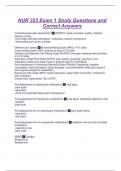NUR 323 Exam 1 Study Questions and
Correct Answers
Comprehensive pain assessment ✅OPQRST: onset, provokes, quality, radiates,
severity, timing
-what might alter pain perception: medication, coping mechanisms
-what makes pain worse or better
Different pain scales ✅Numerical Rating Scale (NRS): 0-10 scale
Visual Analog Scale (VAS): pictures of faces 0-10 scale
Defense and Veterans Pain Rating Scale (DVPRS): how pain interferes with activities
on 0-10 scale
Adult Non-Verbal Pain Scale (NVPS): face, activity, guarding, vital signs, and
respiratory (adds up to equal if pain is great enough for medication)
Pain Assessment in Advanced Dementia Scale (PAINAD): breathing, negative
vocalization, facial expression, body language, and consolability (adds up to equal if
pain is great enough for medication)
Behavioral Pain Scale (BPS): facial expression, upper limbs movement, compliance
with ventilation
Critical-Care Observation Tool (CPOT)
Pre-assessment for opioid pain medications ✅-vital signs
-pain scale
-education
-other non-pharmacological pain management
Post-assessment for opioid pain medications ✅-vital signs, especially respiratory rate
-sedation
-pain level
Pre-assessment for non-opioid pain medications ✅-pain scale rating
-education
-vital signs
Post-assessment for non-opioid pain medications ✅-sedation (not as much as opioid
medication)
-respiratory rate
-pain scale
SBAR ✅Situation
Background
Assessment
,Recommendation
Situation ✅What is going on with the patient? What are you calling about? Introduce
self and title
Background ✅What is the background/context of patient? Diagnosis? Relevant
history?
Assessment ✅What is the problem? Specific information like vital signs and lab values
are stated, clinical impression is stated here
Recommendation ✅What is the next step in managing this patient?
Nursing priority assessments for preoperative patient ✅-informed consent of surgery
-pt education for post-op recovery
-health history/physical assessment: includes allergies, other commorbidities,
drug/alcohol/tobacco use, medication
-been under general anesthesia before? Reaction?
-psychosocial, cultural, and anxiety assessment done
What kinds of issues might need to be reported to the surgeon of anesthesiologist prior
to the patient leaving for surgery? ✅-lab values: hyperkalemia, hypokalemia,
hypernatremia, hyponatremia
-if the health history/exam isn't done then there can be missing information that is vital
for the patient's health and safety: allergies, medications, other commorbidities that
might cause complications
-if a medication that should've been held were given
-if the pt had smoked prior to the surgery (2 weeks prior)
What type of medications should be held prior to surgery ✅blood thinners, aspirin,
nsaids
What type of medications should be given prior to surgery ✅antihypertensives,
antiseizures, acetaminophen-containing pain medications
Therapeutic communication with surgical patient ✅-communication with patient on
education, make sure they understand what is needed for them and what their recovery
will look like for them
Critical assessments ✅high blood pressure (hypertension), WBC (check for infection),
urinalysis, blood glucose level checks (especially in diabetic patient), liver function test
results
Diabetic ketoacidosis ✅-Little to no insulin produced or available
-More common in type 1
, Main problems with diabetic ketoacidosis ✅-hyperglycemia: blood glucose too high
-dehydration and electrolyte imbalance
-metabolic acidosis
Metabolic acidosis ✅-breakdown of fats for energy
-ketones in blood: increase of acid in blood
Who's at risk of DKA ✅-decreased/missed dose of insulin
-illness or infection
-undiagnosed/untreated diabetes
S/s of dehydration and electrolyte imbalance DKA ✅polyuria, polydipsia, weight loss,
lethargy, dizziness, orthostatic hypotension
S/s of ketosis and acidosis ✅acetone breath, nausea + vomitting, anorexia, abdominal
pain, kussmaul breathing (hyperventilation), changes in mental status
Coughing exercises/incentive spirometer ✅This will help the patient to have a higher
oxygen saturation and to improve their lung expansion post-op when they are not able
to ambulate yet.
Lab values of DKA ✅serum ph: 6.8-7.3
Serum bicarbonate: 0-15 meq/L
BUN, creatinine, HCT (increased)
Na+, K+ will vary
Mobility/frequent turning after surgery ✅it will prevent any skin breakdown from being
in the bed, prevent muscle atrophy during the recovery period, and improve peristalsis
(prevents constipation and small bowel obstructions). "If you don't move it you lose it".
DKA treatment ✅-fluid resuscitation
-fluid balance assessment
-monitor/correct electrolytes: KCL 40 meq/L
-treating acidosis and hyperglycemia with insulin: 0.14 units/kg/hr
Hyperglycemia/Hyperosmolar Syndrome (HHS) ✅a metabolic disorder of type 2
diabetes resulting from a relative insulin deficiency initiated by an illness that raises the
demand for insulin
Risk of HHS ✅-type 2 diabetics
-older people
-dehydrated patient
-body isn't making enough insulin




